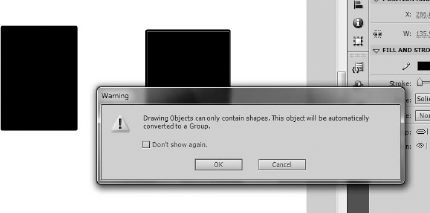Drawing objects were introduced with Flash 8 to make
the drawing environment a little more user friendly. In older versions
of Flash, you had to take special care to avoid unexpected results when
shapes overlapped on the same layer (as described in the section on
working with compound shapes). There are times when compound shapes can
be helpful, but most people will find it easier to work with drawing
objects. If you turn the Object Drawing toggle on (in the Options area
of the Tools panel) at any time, it remains on until you turn it back
off. This makes it easy to draw in the mode that suits you best without
having to remember to turn the toggle on or off all the time.
|
If you draw a shape with the
Object Drawing toggle turned off and decide that you would prefer to
work with a drawing object rather than a raw shape, simply select the
shape and use the Modify => Combine Objects =>
Union command to convert the shape into a drawing object. Conversely,
drawing objects can be reverted to raw shapes by using the Modify => Ungroup or the Modify => Break Apart command.
|
|
In the simplest terms,
drawing objects are containers for raw shapes. They cannot hold
animation (like symbols can) or even other drawing objects. If you try
to add a drawing object to the Stage when you have another drawing
object open in Edit mode, you see a warning dialog box when you return
to the Main Timeline. As shown in Figure 1, Flash automatically converts the original drawing object into a group so that the new drawing object can be nested inside it.

If you have worked in Flash
before, you may be wondering why you would even bother to use a drawing
object instead of just using a simple group to manage raw shapes. Like
groups, drawing objects do not show up in the document library and they
cannot have filters applied to them. However, unlike groups, you can
modify drawing objects without having to open them in Edit mode, and you
can animate them by using Classic motion tweens without first
converting them into symbols. Another key reason to use drawing objects
is to take advantage of the Combine Objects commands (as shown in Figure 2). These commands will be familiar to anyone who has used the Pathfinder panel in Illustrator:
Union: Merges the selected objects into one combined object.
Intersect: Deletes everything except the area of the topmost object where it overlaps the lower objects.
Punch: Deletes the topmost object and punches out the area where it overlaps other objects.
Crop: Deletes everything except the areas of the lower objects where the upper object overlaps.

There are only a few other things to keep in mind when working with drawing objects:
You can modify
drawing objects with the Selection and Transformation tools in the same
way as raw shapes, but you cannot select the fill and stroke inside a
drawing object individually unless you open it in Edit mode.
You
can change the appearance of the fill and stroke separately just by
selecting the object and using any of the swatches menus, but if you try
to apply the Expand Fill command to a drawing object that contains a
stroke, you see the stroke disappear unless you have ungrouped or broken
apart (into raw shapes) the drawing object or opened it in Edit mode.
The
selection highlight for drawing objects and groups selected on the
Stage look exactly alike, but you can tell what type of item you are
working with by checking the item description in the Properties panel.
Groups and drawing objects share some characteristics, but they are not the same thing.
The
Lock Fill option doesn't work with drawing objects in the same way that
it works with other filled shapes. Although you can use the Lock Fill
command to create a fill that visually continues from one object to
another, you will find when you try to apply the Gradient Transform tool
that you have to adjust the fills individually for each object.
NOTE
You also have the option of creating shape primitives by using the Oval
Primitive and Rectangle Primitive tools. Shape primitives have many of
the same advantages as drawing objects, but they can be modified by
using settings in the Properties panel — including handy controls for
rounded corners and precise curves.
|
If you try to open a shape
primitive in Edit mode, you see a warning dialog box with the option of
converting the shape primitive into a drawing object (if you say OK,
you lose access to the special settings in the Properties panel). |